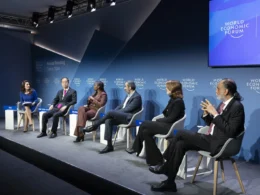healthtransformation
.foundation
Joaquim Cardoso MSc
February 22, 2024
This is an excerpt form the article published by the World Economic Forum in collaboration with the McKinsey Health Institute, written by Lucy Pérez and Shyam Bishen, in January 2024.
What are the key points?
Introduction to the Women’s Health Gap: Despite efforts for gender equity, a significant gap persists between men’s and women’s health in terms of research, data, care, and investment. Closing this gap would not only improve women’s lives but also benefit communities and the global economy.
Potential Economic Impact: Narrowing the women’s health gap could lead to 3.9 billion women living healthier lives and inject at least $1 trillion annually into the global economy by 2040. This would result from fewer health conditions among women, reducing disability-adjusted life years lost and boosting productivity.
Root Causes of the Gap: The gap in women’s health stems from deficiencies in science, data, care delivery, and investment. The default study of human biology focuses on males, leading to less understanding of sex-based biological differences and less effective treatments for women. Additionally, health burdens for women are often underestimated, and women face barriers to care and lower investment in health conditions affecting them.
Charting the Way Forward: Addressing the women’s health gap requires action on multiple fronts, including investing in women-centric research, improving data collection and analysis, increasing access to women-specific care, incentivizing investment in women’s health innovation, and implementing policies supporting women’s health. An ecosystem approach involving various stakeholders is essential for progress.

The article
Foreword
For all the efforts to improve gender equity over the past century, the gap between men’s health and women’s health remains wide, whether it’s in research, data, care or investment.
And every person on the planet is affected by the women’s health gap, whether they know it or not. When we consider the impact of closing the gap, we are not just talking about women’s lives, but those of people we love, our communities and the world at large.
We know it’s possible to reach equity in health for men and women. In this report, Closing the Women’s Health Gap: A $1 Trillion Opportunity to Improve Lives and Economies, we’re pleased to showcase how the narrowing of the women’s health gap would allow 3.9 billion women to live healthier, higher-quality lives.
It could also allow at least $1 trillion to be pumped into economic productivity annually, which reflects how narrowing the gap would lead to fewer early deaths, fewer health conditions, extended economic and societal capacity to contribute, and increased productivity.
Of that, the largest impact would be created from women having fewer health conditions, letting them avoid 24 million life years lost due to disability and boosting economic productivity by up to $400 billion.
Women’s health encompasses more than women-specific conditions, and achieving health equity is possible with intentional, coordinated efforts.
While there are many ways, large and small, for a wide range of organizations to improve women’s health, specific actions could create meaningful impact. Among these are
- investing in women-centric research;
- collecting and analysing sex-, ethnicity-and gender-specific data;
- enhancing access to gender-specific care;
- creating incentives for new financing models;
- and establishing business policies that support women’s health and strengthen women’s representation in decision-making.
We invite leaders from the public, social and private sectors to review this report and find ways to bring their own contributions to filling the gap in women’s health outlined here.
We are excited to see recent momentum in addressing this gap, such as the debut of the Women’s Health Innovation Opportunity Map; the recent creation of the White House Initiative on Women’s Health Research; the launch of the Women’s Health Interest Group from the European Institute of Women’s Health; and news that Australia is on track to become one of the first countries to eliminate cervical cancer.
In this multi-year research effort, the analysis backs up one of the core beliefs of everyone involved: that we all have a role to play in improving women’s lives. As Nobel Prize winner Malala Yousafzai once said, “We cannot succeed when half of us are held back.”
Executive summary
Investments addressing the women’s health gap could add years to life and life to years – and potentially boost the global economy by $1 trillion annually by 2040.
When discussing the challenges in women’s health, a common rejoinder is that women, on average, live longer than men. But this neglects the fact that women spend 25% more of their lives in debilitating health.
Addressing the gaps and shortcomings in women’s health could reduce the time women spend in poor health by almost two-thirds. This has the potential to help 3.9 billion women live healthier, higher-quality lives by adding an average of seven days of healthy living for each woman annually, adding up to potentially more than 500 days over a woman’s lifetime. Beyond the societal impacts of healthier women, including more progression in education and intergenerational benefits, improving women’s health could also enable women to participate in the workforce more actively. This would potentially boost the economy by at least $1 trillion annually by 2040. These estimates – while significant – are likely an underestimation given data limitations.
In this report, women’s health is defined as biological conditions and general health conditions that often affect women uniquely, differently or disproportionately. There are many efforts to improve women’s health globally; however, this report focuses on the economic implications of the women’s health gap and the business case for closing it.
The root causes of the gap
There are four primary areas that need to be addressed to close the health gap:
1. Science: The study of human biology defaults to the male body, which hinders understanding of sex-based biological differences and results in fewer available and less effective treatments for women.
2. Data: Health burdens for women are systematically underestimated, with datasets that exclude or undervalue important conditions.
3. Care delivery: Women are more likely to face barriers to care, and experience diagnostic delays and/or suboptimal treatment.
4. Investment: There has been lower investment in women’s health conditions relative to their prevalence. This drives a reinforcing cycle of weaker scientific understanding about women’s bodies and limited data to de-risk new investment.
These factors play out in many different ways and to varying extents across regions and income levels. However, the evidence suggests that no geographic region or age group is unaffected.
Charting the way forward
Moving forward requires understanding the broader effects of the women’s health gap, and driving action on five fronts:
- Invest in women-centric research across the research and development (R&D) continuum to fill the gaps in under-researched, often undiagnosed women-specific conditions (for example, endometriosis, and pregnancy and maternal health complications), as well as diseases affecting women differently and/or disproportionately (for example, cardiovascular disease).
- Strengthen the systematic collection, analysis and reporting of sex- and gender-specific data to establish a more accurate representation of women’s health burden and evaluate the impact of different interventions.
- Increase access to women-specific care in all areas, from prevention to treatment.
- Create incentives for investment in areas of women’s health innovation and develop new financing models.
- Implement policies supporting women’s health, such as academic institutions adapting medical school curricula and employers creating pregnancy- and menopause-friendly workspaces.
An ecosystem approach, involving multi-sectoral stakeholders, is needed to accomplish these goals. It is possible to create better health for women, allowing greater workforce participation and, most importantly, the ability to live healthier lives.
Contents of the longe version of the paper
Foreword
Executive summary
Introduction
1. The role of science in addressing health disparities
2. Data gaps underestimate women’s health burden, limiting
innovation and investment
3. Creating sex- and gender-responsive care delivery systems
4. Directing investments towards women’s health
5. Closing the women’s health gap could boost the global economy
6. Call to action: How to close the women’s health gap
Conclusion
Contributors Endnotes










